A continuation of https://garden.org/ideas/view/...
1. Kill the adult weevil on sight, without exception.
Vine weevils are all female, and all egg layers, delivering maybe 200 growing larvae into your plant environment. When you see an adult, kill it or expect two hundred larvae. Other than that, the effort to kill the adults, unless you are running a nursery, is probably not worth the effort, or the danger to the environment and maybe to yourself from the chemicals you would be using. Sometimes you get advice to go outside in the dark and tap the bushes over newspaper, at which point the adults should fall out. Good luck. By then I am too tired to bother with them, and looking for black insects in the dark seems arduous.
2. What are the signs that an adult is about?
Well, if the plant has notches on the leaves, that is the usual sign. The variety of plants is quite wide (see Vine Weevil, Part One), but the notches look like this:

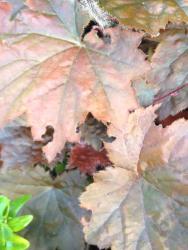
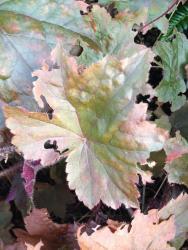
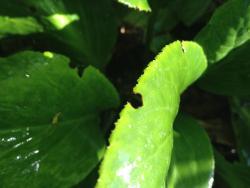
During daylight you would be lucky to find an adult on the Bergenia, Primula, or Heuchera in the examples above, and strangely, the larvae prefer the roots of Primula and Heuchera, but don’t bother so much with the Bergenia. Again, I don’t recall seeing an adult, or even adult damage, on a sedum, but these plants are loved by the larvae. The main point is to observe that you have damage from the adult and think of the two hundred larvae near by. Some plants, such as Heuchera, are doubly cursed, with adults loving the leaves, and larvae munching the roots.
3. Concentrate on the larvae.
The larvae eat the roots. Small larvae eat small roots, maybe 8 inches deep in the soil, and large larvae eat larger roots just under the ground, directly under the plant. If you see one larva, you most likely have twenty, so keep digging and looking. They stay close to the food source -- the roots.

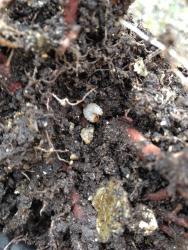
Above you can see a fine crop of larvae in a jam jar lid, and on the right a larva sitting under the centre of the root ball of a primula as I hold the plant upside down. Unless you are prepared to dig the plant out and entirely wash the soil off, you will not see the large ones as they sit right under the centre of the plant at the nexus of the main roots.
When you do wash them off, the damage is most disheartening, and you are tempted to throw the plants away. Don’t do this. The weevil has just divided your plants for you. You have been given lemons, and now you can make lemonade. If you look at the photographs below, you can see what a healthy root formation for a young candelabra primula looks like. The first picture is of the entire plant. The second photograph is of the root ball. You can see how each separate root strand ends in a forest of fine feeding roots.
In the second photograph, I have turned the photograph upside down so you can concentrate on the roots themselves. This is a beautiful, pristine root ball -- perfect.


The next two photographs show the damage from the feeding larvae on Primula bulleyana. Small larvae eat the fine roots, and alpha larvae eat the anchor and master roots from which the fine root balls develop, cutting off the entire ball below the surface. The plant tries to produce leaves, it wilts, you water it, and it dies anyway. Without roots, there is no way for the leaves to stay lush. These photos below were taken in February, as I acted on a hunch after a very mild winter and dug up a 4-ft-square primula raised bed for growing on, and -- sure enough -- the larvae were all overwintered and fat as butter balls.
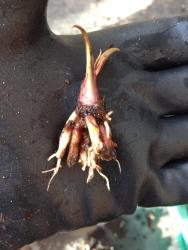
In the case of the Primula family, the larvae prefer the candelabra types with the root system you see above, rather than the early Primula denticulata, or Primula secundiflora (second photo below) and the root system you see below, chewed and unchewed. I think the larvae go after big roots as they develop and the secundiflora is too much work if there is an alternative. I guess it is the same reason big ferox trout act like pike and tend not to chase the balls of fluff and feathers fly fishermen loop at them.


In the case of Heuchera, the first you usually know of it, if you haven’t seen the notches, is when the top of the plant breaks off and rolls away like a tumbleweed. If you see the adult damage on a Heuchera in the ground, dig the plant up immediately, wash off all the soil, and put the plant aside in a pot for treatment.
In any case, let’s try to save the plants. For this example I will use a sedum, Hylotelephium 'Herbstfreude.' This potted plant was not thriving, although it was well watered. I took it out of the pot, and lo and behold: There was the monster, lurking right under the neck of the plant, where you can’t get it unless you wash off all the soil. You can see the mandibles on the very healthy larva, but where is the root ball? It is largely gone.

Above you see a sedum from a pot, with the resident larva. To the right of the larva is the main root of the plant, heavily gnawed, and the photo below shows the disintegration of the plant when the soil is washed off.
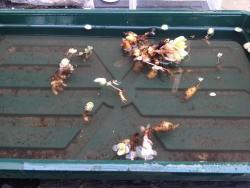
At this point many people would discard the plant, but really all that has happened is that you now have ten small plants. The photo below shows the little we have to work with, but just pot the plants up anyway.
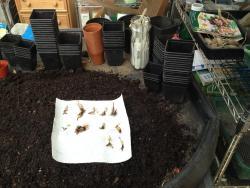
The best way to think of them is as seedlings. After all, if we had seedlings like these, we would be pretty confident that all of them would thrive when potted on. So, pot each piece up in a 9-cm-square container (or whatever is handy for you), don’t water for a couple of days, and then put them in a tray in shade under the bench for a week or two so they can find their feet. After that, treat them as seedlings. No direct sun for a month, but a bright environment.
While sedums are particularly hardy and easily recover, the same result has been achieved with heucheras and various primulas.
Here are the little sedum pieces after potting, five weeks later, and then eight weeks later. They should have been rotated, but I forgot about them when I put them under the bench. They’ll straighten up. The main thing is that they are alive and well. Hey, nobody's perfect.

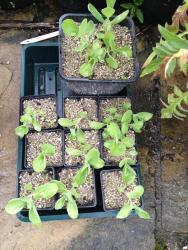
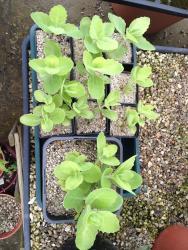
..........and look at the Primula bulleyana after six weeks:

I plant the recovering plants in a soil-based compound and I avoid the multi-purpose type of medium. The larvae and the weevils don’t enjoy that soil compound as much. I tamp the soil with a soft brush and then cover the plant pot surface first with sand and then with grit. Apparently, the weevils have a very sensitive egg-laying pipe and really dislike the scratchy stuff.
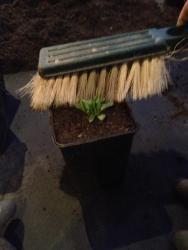
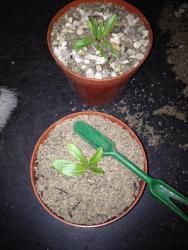
At the appropriate time, dose the potted-up plants with nematodes, while they are sitting in a watering tray, and then you can recycle the water with the nematodes that flows through the pots. Water the pots the day before so that the soil will already be wet.
I plan to dose with nematodes two or maybe three times a year, while the soil is at the correct temperature and WHILE THE LARVAE ARE PRESENT. If you dose while the population is mainly adults, you are wasting your time and money. If the plant is in a bed and the bed is infected, then water the bed the day before you dose it with nematodes. The larvae are in the roots of the plant, not sprinkled all over the bed. Like maggots, they are on top of their food.

The tray being watered with nematodes above is the same candelabra primula ( the Primula bulleyana) that the weevils had destroyed. Look how healthy they are! They did bloom later and smaller than usual, but they are in good shape for next year. So you should be able to save your plants and get a new population of what you could regard as seedlings or cuttings. Don’t be worried about potting them up. They have a great will to live and will come back from almost nowhere to become full plants.
Let's also remember that there are great friends in the garden too, such as this bunch of little fellas sitting on the end of an Echium pininana before the flower shoot shot up six feet.
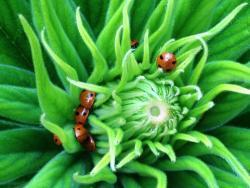
Hope this is helpful,
Peter
| Thread Title | Last Reply | Replies |
|---|---|---|
| Excellent! by sheryl | Aug 23, 2014 10:03 AM | 0 |